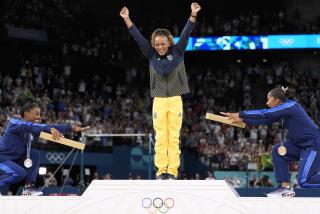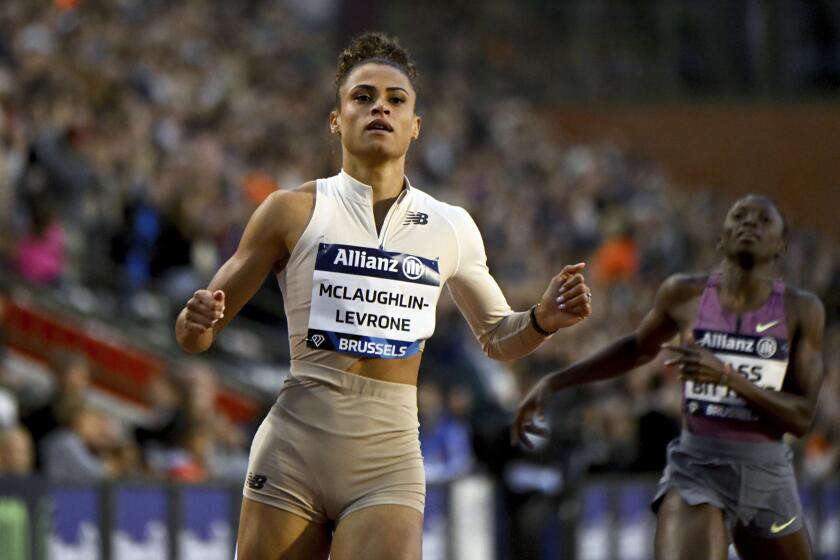THE DAY AFTER
- Share via
ATLANTA — Before casting begins for the Kerri Strug made-for-TV movie “My Left Foot,” let us review the fundamental elements of the vault that landed Strug on Wednesday morning’s “Today” show and out of tonight’s all-around competition.
Technical description: A Yurchenko 1 1/2 twist in the layout position--a vault former coach Peggy Liddick says Strug has performed “thousands of times.”
Approach: Lots of fast, tiny steps, some of which Strug actually could feel.
Takeoff: NBC’s Tuesday night ratings did exactly that.
Landing: Too painful to watch, although most of the free world did.
Immediate impact on United States: Gymnastics schools have operators on hand, ready to take your call.
Immediate impact on Strug: Two torn ligaments in the left ankle, no chance at an all-around medal, wishfully thinking about a possible go in the individual event finals Sunday and Monday nights.
Bottom line: Totally captivating, totally unnecessary.
The first Bud Greenspan moment of these Olympic Games comes attached to an asterisk--a bit of punctuation with which NBC Sports is apparently unfamiliar. Strug’s final vault in Tuesday night’s women’s gymnastics team finals was everything good television should be--high drama, hefty yank on the heartstrings--but it did not bring home the gold medal for the United States, as NBC breathlessly assured a nation it had.
With or without Strug’s climactic second vault attempt of 9.712, the Americans would have edged the Russians for the gold. Take nothing away from Strug’s achievement; her stick-and-grimace landing is the Kirk Gibson World Series home run of women’s gymnastics, as gutty and inspiring as Willis Reed’s long limp onto the Madison Square Garden floor for Game 7 of the 1970 NBA finals.
But if Strug had never attempted that vault--not an unhealthy idea, in retrospect--the United States still would have defeated the Russians, only by .309 instead of .821.
Strug was jumping, at Coach Bela Karolyi’s urging, to erase a weak 9.2 score by the vaulter who preceded her, Dominique Moceanu. In Olympic women’s team gymnastics, six gymnasts per country compete in each event, but only the top five scores count toward the team total. The object, then, is to isolate the low score and obliterate it from the record.
Strug hadn’t done it with her first try; instead she wrenched her ankle, falling and getting tagged with a 9.162 score. But she still had another try coming; female gymnasts are permitted two vaults, with the higher score counting.
With her 9.712 second vault, Strug knocked out Moceanu’s 9.2, giving the Americans a final team total of 389.225, compared to the Russians’ 388.404. But if Strug had never vaulted at all, Moceanu’s 9.2 would have stood and the Americans would have finished the meet with a final score of 388.713--still better than the Russians.
And if the Americans didn’t need Strug to vault, Strug could have avoided the third-degree lateral ankle sprain that left her on crutches and forced her to withdraw from tonight’s prestigious all-around competition.
Strug had legitimate hopes for an all-around medal. Individually, she was ranked seventh in the team competition--her overall score of 77.735 was only .251 out of third place and her floor exercise was the top-ranked in the field.
She officially withdrew Wednesday evening, as lineups are due 24 hours before the event, and was replaced by Moceanu. Strug also qualified for individual floor exercise and vault finals, to be held Sunday and Monday, and is holding out hope of still competing. According to Olympic rules, she does not have to announce her decision until 30 minutes before the apparatus finals.
“I had a goal of making the individual all-around,” said Strug, visibly disappointed. “I didn’t accomplish it in 1992. And now, to achieve it and . . . not be able to compete is hard.”
Strug took one for the team, carrying the Americans over the top and then some, but the fallout raises serious questions about a coach’s responsibility to his or her athlete and the strict time constraints that govern gymnastics.
Regarding the numbers the United States needed in order to clinch the gold medal: What did Strug’s coaches know, and when did they know it?
Tuesday’s fourth and final rotation had the first-place Americans performing on the vault and the second-place Russians the floor exercise. The Americans began the rotation with a lead of .897. In the four-ring circus of women’s gymnastics, teams compete simultaneously, and because a vault is over in a snap of the fingers and each floor routine lasts between 70 and 90 seconds, the Americans finished well before the Russians.
Strug was the Americans’ last competitor of the night. By the time she landed her first vault with a slip and a slide and a 9.162, the Russians still had two gymnasts yet to complete their floor exercises--their two best, Dina Kochetkova, the European bronze medalist, and Rozalia Galiyeva.
“We knew we had a lead of eight-tenths of a point,” Liddick said. “If we use Moceanu’s 9.2 and the two Russians both get 9.9s, that eighth-tenths is out the window.”
Strug and her coaches couldn’t afford to wait and watch Kochetkova and Galiyeva close the evening with insufficient scores of 9.725 and 9.5. Strug had 45 seconds to hobble back to the top of the runway for her second vault attempt and then, once the green light flashes, 30 seconds to complete that vault.
Seventy-five seconds for the U.S. coaches to calculate whether the team still needed Strug to try it again--amid the cacophony of nearly 32,000 voices inside the Georgia Dome rising to the occasion.
You try to do that math.
“We’re only allowed two coaches on the floor,” said Kathy Scanlan, president of USA Gymnastics. That would be head Coach Martha Karolyi and assistant coach Mary Lee Tracy. Personal coaches, such as Bela Karolyi for Strug and Steve Nunno for Shannon Miller, were consigned to the outer perimeter of the floor, stationed behind a three-foot-high partition.
“Two coaches--and they’re busy with their athletes,” Scanlan said. “How are they supposed to be punching a calculator out there? It’s impossible unless you’re a human adding machine.
“Once the green light goes, you have to go. It’s not like football. You can’t call timeout and say, ‘Wait, I’m going to think about this vault.’ ”
If so, why not?
Why not an injury timeout for exceptional cases such as Strug’s? Strug didn’t have time to know if her vault was necessary or, really, to see if her leg could withstand the attempt. When she heard Karolyi yell, “We need another, Kerri!” she reacted impulsively.
“I will! I will! I will!” she called back, and lined up the run that left the rest of the world grimacing.
It was a gripping moment, inspiring and unforgettable. And, in a less imperfect world, it never would have needed to happen.
* WHO’S BEST?: Would the U.S. gymnastics team still have won the gold if Soviet Union had not broken up? S12
More to Read
Go beyond the scoreboard
Get the latest on L.A.'s teams in the daily Sports Report newsletter.
You may occasionally receive promotional content from the Los Angeles Times.






